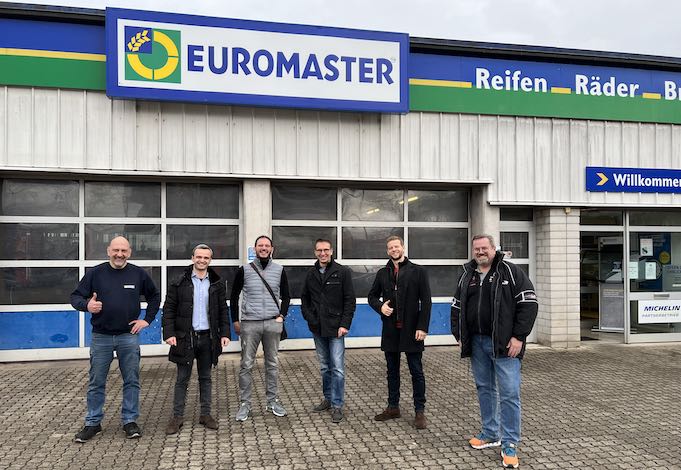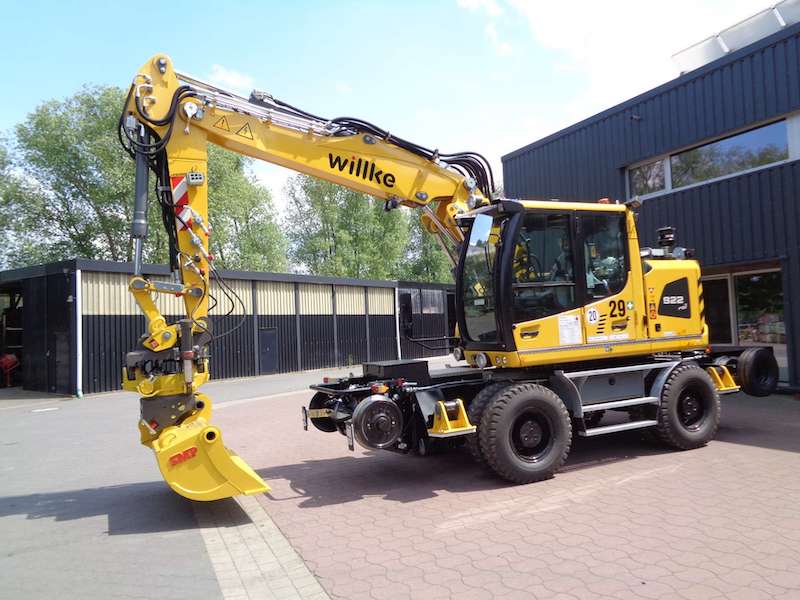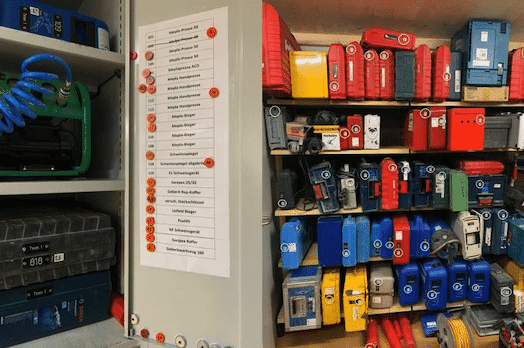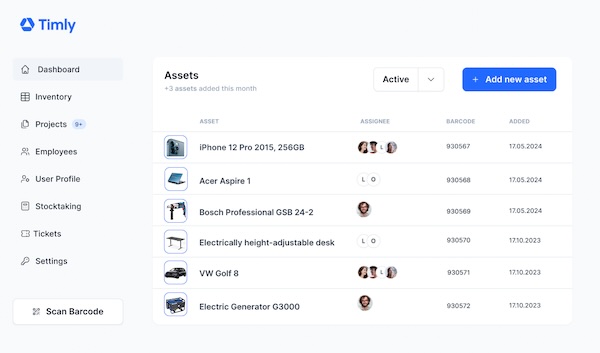Medical Equipment Maintenance: Strategies and Best Practices
- What is medical equipment maintenance?
- The importance of proper upkeep of healthcare equipment
- How to maintain, service and repair medical equipment
- The different approaches: Reactive, Preventive and Predictive Maintenance
- Proactive maintenance of healthcare equipment
- Timly – Your 360° cloud solution for medical equipment and more
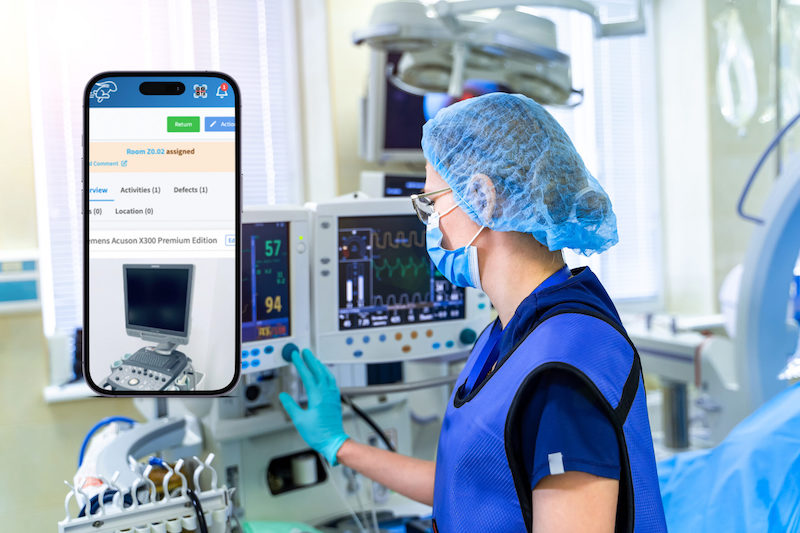
Keeping on top of your medical equipment maintenance with the Timly cloud-based solution.
What is medical equipment maintenance
Medical equipment maintenance is a broad term which refers to the process of ensuring that any medical or biomedical equipment is working properly and is fully functional. Specifically in asset tracking we mean the following things:
∗ Monitoring the operating condition and performance of medical equipment
∗ Monitoring the performance, compatibility, update status and security risks of all supporting software, firmware, IT equipment and networks
∗ Conducting proper and regular servicing – testing batteries, lubricating, adjusting, cleaning, inspecting and more
∗ Repairing any breakdowns and/or restoring full functionality
∗ Knowing and using manufacturer or vendor support and warranty services
∗ Understanding and following all requirements – governmental, institutional and/or corporate – around medical equipment maintenance, including compliance, disclosure and reporting
This includes equipment used for evaluating, monitoring, diagnosing and treating patients, as well as in medical research, innovation and product development, and which can be found in hospitals, clinics, outcare facilities, doctor’s offices, long-term medical care facilities, research labs and more.
The importance of proper upkeep of healthcare equipment
The importance of comprehensive and effective maintenance of medical equipment cannot be overstated. Failure or less than optimal performance in monitoring, diagnostic, life-support or other medical equipment can and will mean degradation of medical care, diagnostic errors, ineffectiveness in treatment, and even loss of life.
Another consideration is that deviance from statutory requirements around medical equipment maintenance can have strong legal and financial consequences. This is of little consequence compared to the human consequences of equipment failure, but let’s not forget that non-compliance, and the resultant expenses (and even censure or loss of accreditation) can severely impact your ability to help patients.
For more detailed information on statutory requirements, reporting and compliance in the UK and Northern Ireland, we recommend consulting the NHS’s Health Technical Memorandum 00: Policies and principles of healthcare engineering, and for the Republic of Ireland you should follow current EU requirements, which are largely outlined in the Health Services Executive’s Medical Equipment Management Policy.
Keep in mind, though, that it is fully the responsibility of a healthcare facility, its management and staff, to know and follow all regulatory requirements related to healthcare equipment procurement, installation, use and maintenance, and even if the above documents were correct and current at the time of this writing you should determine if they still are, and if and how they apply to your facility and its operations.
Over 600 Companies, Schools and Cities Rely on Timly
How to maintain, service and repair medical equipment
It is beyond the scope of this short blog article to really describe or explain any maintenance procedures. For one thing, it is too technical and too complex – and too crucial of an operation – and so professionally produced and prepared documentation on operation and maintenance of medical and biomedical equipment is the only way forward.
And for another thing, the maintenance of a specific machine can be vastly different than another machine, even if they have identical functions, and can vary greatly depending on many other factors, including amount, frequency and type of use, environmental conditions, staff training and knowledge, interaction with other equipment, quality of previous maintenance procedures and more.
So again, consulting official documentation and availing yourself of all qualified support available – from the manufacturer, the vendor or the industry, not to mention any governmental or institutional entities – is so important, and a complete understanding of maintenance from all perspectives can really raise the effectiveness and stature of your health care facility.
The different approaches: reactive, preventive and predictive maintenance
Reactive Maintenance – the oldest and still most common approach to maintenance, reactive maintenance is performed only, or primarily, when a machine has failed or is clearly not operating correctly.
For obvious reasons, this approach is almost wholly inappropriate for medical equipment, and in most other industries this inefficient and expensive strategy is being rethought, and has largely been discarded.
Preventive Maintenance – preventive maintenance seeks to prevent equipment failure by anticipating service and maintenance needs. Regular maintenance and servicing is performed not when a machine acts up or shuts down, but on an optimal pre-determined schedule.
While a more appropriate approach for healthcare facilities, preventive maintenance can be more costly than reactive maintenance, and still doesn’t prevent equipment failure, malfunction or deterioration nearly as effective as the last approach we’ll consider – predictive maintenance.
Predictive maintenance – associated with Industry 4.0, the Internet of Things (IoT) and artificial intelligence (AI), predictive maintenance is a wholly new approach to maintenance which is redefining the process across industries.
With predictive maintenance, also known as proactive maintenance, data sets and real-time data provided by sensors on the equipment are analysed using artificial intelligence. This allows accurate predictions of when a machine, system or service is most likely to fail as well as the optimal time to execute maintenance procedures.
Clearly the best maintenance strategy for healthcare, this new approach consistently extends the life and improves the effectiveness of equipment and reduces service interruptions and failures, saving time, effort and money.
Asset Management Software in Use by Our Customers
The Timly software is continuously evolving to meet the needs of our customers. In various success stories, we show you how Timly optimizes processes in companies, thereby saving significant effort. With Timly, inventory management becomes child’s play.

Optimized Device Management With Innovative Self-Inventory
SodaStream is the world market leader for water sparkling systems for domestic use and has a lot of IT equipment at its various locations. Many colleagues now work from their home offices. A digital solution for the efficient management of IT end devices became necessary...
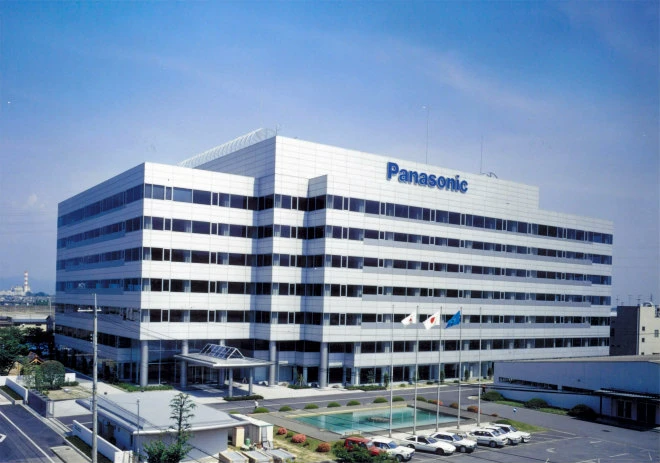
Panasonic x Timly: Driving Technological Innovation
One of the most remarkable aspects of human ingenuity is our ability to innovate. Innovation is embedded in the DNA of consumer electronics giant Panasonic, which has diversified into a number of sectors, from heavy industry to construction...
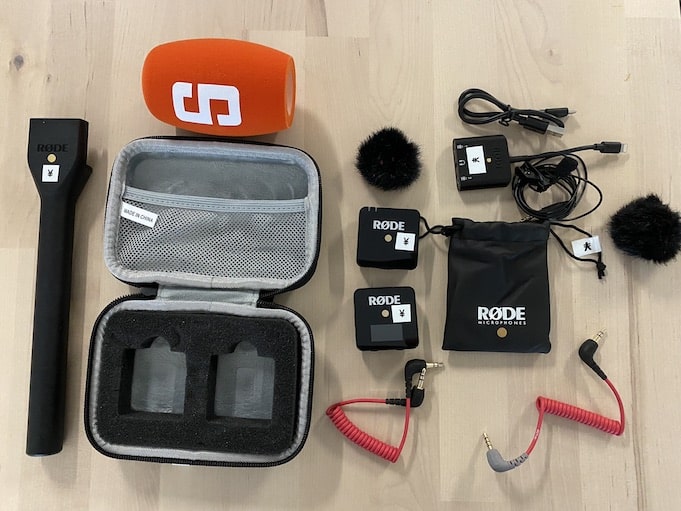
Manage Video Equipment Efficiently Without Much Effort
The Hamburg media company always does outstanding journalistic work and is characterized by independent reporting. In order to maintain journalistic quality, the teams work with highly specialized devices – these need to be managed efficiently...

Smart City Asset Management – Timly in Use at DIGOOH
The core business of DIGOOH Media GmbH in Cologne is to manage digital city light posters (DCLP) for outdoor use in various cities in Germany. The challenge here lies in making the client’s communication message always available at the right time, in the right place...
(No credit card required)
Predictive maintenance of healthcare equipment
Proactive maintenance using AI and real-world data is enormously effective and beneficial in each and every use case, application and industry in which it has been employed, but it is perhaps most advantageous in healthcare applications. The benefits include:
Reliability – predictive maintenance solutions are demonstrably much more effective in preventing equipment failure and performance degradation, and will lead to better and more reliable patient care on all levels.
Cost effectiveness – predictive maintenance means less trained service staff need to be kept on, allowing personnel budget to go instead to medical and support staff. It also significantly reduces the need for stocking replacement parts, supplies and even tools, and extends the lifespan of equipment and machinery.
Of course in the current and assuredly ongoing reality of budget cuts and limited resources, these cost savings can be an extraordinary boon for any medical facility of any size.
Availability – proactive maintenance increases the effectiveness of maintenance procedures and reduces the frequency and time of that maintenance, meaning reduced downtime for critical monitoring, diagnostic and support machinery, less employee stress and improved patient care.
Though not specifically focused on the healthcare industry, you can find an even more complete look at the details and benefits of predictive maintenance in the following article: What is CMMS and Does Your Business Need CMMS Software.
Timly – Your 360° cloud solution for medical equipment and more
The idea of deploying real and functional preventive maintenance in an established medical facility of any type can be daunting, given assumptions about complexity and logistics, possible interruptions in service and revenue, and the prohibitively high costs of implementation.
But this is exactly why inventory management solutions like Timly’s asset tracking software have become so popular in recent years, and why so many companies, facilities and organisations of all types have been able to enter into the world of Industry 4.0 – even if they believed such a transition not feasible or even impossible.
Take care of all your medical equipment maintenance needs with Timly’s cloud software.
Timly’s asset management platform offers a holistic approach to preventive maintenance that is easily installed and implemented, minimises interruptions in service, workflow and revenue, is surprisingly inexpensive initially and will provide a rapid ROI (return of investment).
Through seamless integrations with companies like adnexo and Lansweeper, Timly can offer true predictive maintenance, fully utilising the power of the IoT (internet of things) and AI (artificial intelligence) to make sure your facility’s medical equipment, computers, software, networks and all related systems, are as reliable as possible, as well as ensuring full regulatory compliance and streamlining all related disclosure and reporting.
At the same time, you can easily avail yourself of the rest of Timly’s extensive features and services – all part of the same user-centric asset management platform. We can help you improve and optimise every aspect of your business, from the availability and procurement of medicines and other supplies to the management of staff, including their availability, qualifications and certifications, allowing for improved decision-making, better use of resources, and countless other ways of increasing productivity and saving money.
Recommended for you
Book an online demo - free and without obligation - or create your free trial account directly.






